If your dog is shedding more than normal, you may be wondering what the problem is. This post shares 13 questions and answers about dogs shedding more than normal.
Do you have trouble with dog hair all over your clothes and furniture? You’re not alone. Millions of people are dealing with the same issue. In this blog post, we’ll answer some of your most common questions about dog shedding. By the end, you’ll know exactly what to do to reduce the amount of hair your dog sheds. Let’s get started!
How Do You Stop Dog Hair Shedding?
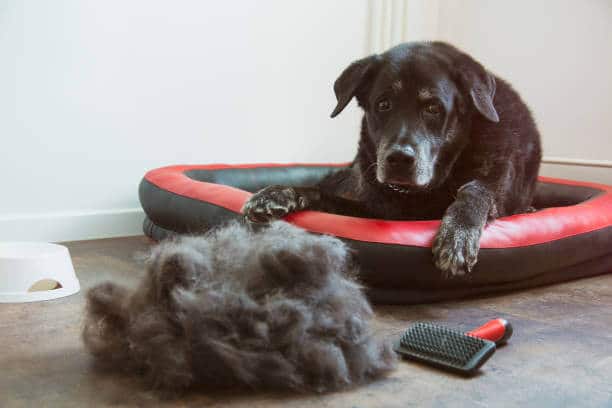
Dogs are natural shedders. They lose old or damaged hair to make room for new growth. But sometimes, dogs shed more than usual. This can be due to stress, illness, changes in the environment or season, or poor nutrition.
If you’re concerned about your dog shedding more than normal, there are a few things you can do to help reduce it. Here are eight tips and tricks:
1. Give your dog a regular brushing: Brushing helps remove dead hair and distribute the natural oils from the skin throughout the coat. This helps to keep the coat healthy and reduces shedding.
2. Use a deshedding tool: Deshedding tools help remove loose hair that’s ready to fall out. This can help reduce the amount of hair your dog sheds on a daily basis.

3. Feed your dog a healthy diet: A healthy diet helps to keep the coat healthy and can reduce shedding. Look for a diet that’s rich in omega-3 fatty acids, which are known to promote a healthy coat.
4. Keep your home clean: A tidy home means fewer places for loose hair to accumulate. Regularly vacuum and dust to help reduce the amount of hair shed around the house.

5. Give your dog occasional baths: Bathing helps remove loose hair and keep the coat clean. Use a mild shampoo designed specifically for dogs and avoid overbathing, which can dry out the skin and lead to more shedding.
6. Keep your dog’s fur trimmed: Trimming the fur can help reduce shedding by removing some of the dead hair. Ask your groomer for a trim that will help reduce shedding without making your dog uncomfortable.
7. Avoid stress: Dogs that are stressed shed more than those that are relaxed. Do what you can to keep your dog calm and reduce stress in their life. This may include daily walks, providing toys and chewing bones, and avoiding changes in the home or environment.
8. Visit the vet: If you’re concerned about your dog’s shedding, make an appointment with your veterinarian. They can rule out any underlying health conditions that may be causing the excessive shedding.

Any/all links on this site may be affiliate links, and if you make a purchase through one of them, I will earn a small commission at no extra cost to you. Read the full affiliate disclosure here.
What Causes A Dog To Shed Excessively?
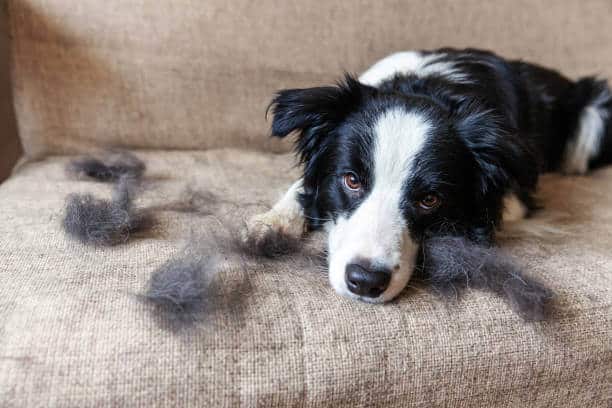
Dogs are covered in fur, which means that shedding is a natural and necessary process for their health. However, sometimes dogs shed excessively, and this can be caused by a number of different factors.
One possible reason for excessive shedding is an underlying health condition. Dogs with allergies or skin conditions may scratch more frequently, which can lead to increased shedding.
Hormonal imbalances can also cause excessive shedding, as can other health problems like thyroid disease or Cushing’s disease. If your dog is suddenly shedding more than usual, it’s important to take them to the vet to rule out any potential health concerns.
Poor nutrition can also cause excessive shedding. Dogs who are not getting enough of the right nutrients in their diet will often have dull, dry coats that are more prone to shedding.
If you suspect that your dog’s diet may be the cause of their excessive shedding, talk to your vet about switching to a food that is specifically designed for dogs with sensitive skin or allergies.
Finally, some breeds of dogs simply shed more than others. Dogs with double coats, like German Shepherds and Labrador Retrievers, shed seasonally as they lose their winter coat.
Other breeds, like Poodles and Bichon Frises, have hair that grows continuously and needs to be trimmed regularly to prevent matting and excessive shedding. If you’re not sure whether your dog’s breed is prone to excessive shedding, ask your vet for advice.
Excessive shedding can be frustrating, but luckily there are a number of things you can do to help manage the problem.
Regular brushing will help to remove loose hair from your dog’s coat, and using a deshedding shampoo or conditioner can also be helpful.
If your dog’s excessive shedding is caused by a health condition, treating the underlying problem should help to reduce the amount of shedding.
What Months Do Dogs Shed The Most?
Dogs typically shed more in the spring and autumn. This is due to the change in temperature and daylight hours. Dogs that live in warmer climates may shed year-round.
Dogs shed their coats for a variety of reasons, including to regulate their body temperature, to get rid of damaged or old hair, and to regulate themselves in different seasons.
Dogs with thick double coats shed the most, as they have more hair to lose.

What To Feed Dogs To Reduce Shedding?
Dogs are wonderful, loyal companions that bring so much joy to our lives. But when they start shedding more than normal, it can be a real nuisance. Dogs shed their hair for a variety of reasons, including changes in the weather or seasons, stress, poor nutrition, and health problems.
There are a few things you can do to help reduce your dog’s shedding. One is to feed them a diet that is rich in omega-3 fatty acids.
Foods like salmon, sardines, herring, flaxseed oil, and olive oil are all great sources of omega-3s. Adding just a little bit of these healthy fats to your dog’s food can make a big difference in their coat and skin health – and therefore, their shedding.
If your dog is shedding more than normal, it’s always best to check with your veterinarian to rule out any health problems. But in many cases, simply adding some omega-3s to their diet can help reduce shedding and keep your dog’s coat looking healthy and shiny.
How Long Does A Dog Shedding Last?
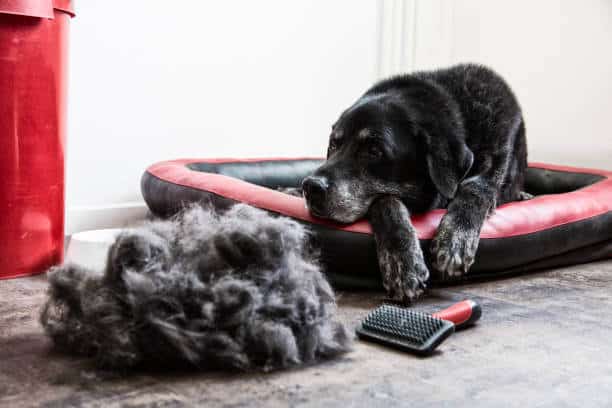
Dogs typically shed their winter coats in the spring and their summer coats in the fall. However, some dogs shed year-round. Dogs that shed more than normal may be experiencing health problems or allergies.
The shedding season for a puppy usually lasts about 6 weeks. During this time, they will lose their baby coat and grow their adult coat.
Older dogs shedding typically lasts for about 3 weeks. Dogs that are older may shed more due to age-related hormonal changes.
Dogs that shed more than normal may be experiencing health problems or allergies. If your dog is shedding excessively, you should consult your veterinarian.
Do Dogs Shed When Stressed?
Dogs are known to shed their fur when they are stressed. The reason behind this is that when a dog is stressed, their body releases a hormone called cortisol.
Cortisol is a stress hormone that causes the body to release natural oils in order to protect the skin. These oils make the fur coat look greasy and matted.
Dogs will often shed more fur when they are stressed because they are trying to get rid of this excess oil.
You may also notice that your dog may start shedding in the vet’s office or during a grooming appointment. This is because these are both situations that can be stressful for dogs.

Dogs may also shed more fur when they are in a new environment or around new people. This is because they are not used to these surroundings and may feel anxious or stressed.
If you notice that your dog is shedding more fur than normal, it is important to take them to the vet to rule out any medical conditions. There are a number of skin conditions that can cause excessive shedding, so it’s important to get a diagnosis from a professional.
Once any medical conditions have been ruled out, you can work on helping your dog feel less stressed. This may involve providing them with more exercise, attention, and enrichment activities.
Dogs that are well-adjusted and have a good quality of life are less likely to shed excessively from stress.
If you are concerned about your dog’s excessive shedding, talk to us here at Our Dogs World 101 about possible causes and treatment options. Dogs that are shedding more fur than usual may be trying to tell you something, so it’s important to listen to their needs.
How Much Dog Shedding Is Normal?
Dogs are known to shed, especially during certain times of the year. But how much shedding is considered normal? Dogs typically shed their outer coat once or twice a year in response to changes in seasons and temperature.
The amount of hair that is shed depends on the breed of dog, as well as whether the dog has a double coat. Dogs with double coats typically shed more than those with single coats.
Between those two major shedding seasons, most dogs will lose some hair every day.
The amount of daily shedding varies from dog to dog, but it is usually not noticeable unless you are petting your dog and feel a few hairs come off on your hand.
If you notice that your dog is losing an abnormal amount of hair, or if the hair that is being shed looks unhealthy, it is time to talk to your veterinarian.
What Dog Sheds The Most Hair?
Dogs are considered one of the best companions a person could have. They’re known for being loyal, loving, and protective. But one downside to owning a furry friend is the shedding.

Dogs shed year-round, but some dog breeds shed more than others. If you’re looking for a low-shedding dog breed, you might want to avoid the following eight breeds.
- Great Pyrenees are large, gentle giants that were originally bred to protect sheep from predators like wolves and bears. These dogs have a thick double coat that sheds heavily year-round. If you’re considering the Great Pyrenees, be prepared to vacuum often and use a lint roller on your clothes.
- Alaskan Malamutes are another large breed of dog that sheds a lot. These dogs were originally bred for sledding, and they have a thick coat of fur to protect them from the cold weather. Alaskan Malamutes shed more heavily in the spring and fall, but they can shed throughout the year.
- German Shepherds are one of the most popular breeds of dogs, but they also happen to be heavy shedders. German Shepherds have a double coat of fur that sheds year-round.
- Siberian Huskies are another popular breed of dog that sheds a lot. These dogs were originally bred for sledding, and they have a thick coat of fur to protect them from the cold weather. Siberian Huskies shed more heavily in the spring and fall, but they can shed throughout the year.
- Labrador Retrievers are one of the most popular breeds of dogs, and they’re also heavy shedders. Labrador Retrievers have a double coat of fur that sheds year-round. If you have a Labrador Retriever, you’ll need to vacuum often and brush your dog’s fur regularly.
- Akita is another popular breed of dog that sheds a lot. These dogs were originally bred in Japan, and they have a thick coat of fur to protect them from the cold weather. Akitas shed more heavily in the spring and fall, but they can shed throughout the year. I
- Chow Chows are large dogs that were originally bred in China. Chow Chows have a thick coat of fur that sheds year-round. If you’re considering a Chow Chow, be prepared to vacuum often and use a lint roller on your clothes.
- Golden Retrievers are one of the most popular breeds of dogs, but they also happen to be heavy shedders. Golden Retrievers have a double coat of fur that sheds year-round. If you have a Golden Retriever, you’ll need to vacuum often and brush your dog’s fur regularly.
If you’re looking for a low-shedding dog breed, you might want to avoid the eight breeds of dogs listed above. Dogs that shed the most hair can be a lot of work, but they’re also loyal, loving, and protective companions.
Do Eggs Stop Dogs From Shedding?
If you’re noticing that your dog is shedding more than normal, it might be time to try using eggs to help control the problem. Eggs contain biotin, which is a vitamin that helps keep skin and fur healthy.
Dogs lacking in biotin can have dry, brittle fur that sheds excessively. Adding eggs to your dog’s diet can help add back biotin and improve the condition of their fur.
There are a few different ways you can feed your dog eggs. You can either scramble them and mix them in with their food, or you can feed them hard-boiled eggs as a treat.
If your dog is resistant to eating eggs, you can also try using an egg supplement. These are available at most pet stores and can be added to your dog’s food or water.
If you’re not sure how many eggs to feed your dog, start with one per day and increase as needed.
Eggs strengthen hair follicles to give your dog a healthy, shiny coat but will not significantly decrease shedding. If your dog is shedding more than normal, you should consult with a veterinarian to rule out any underlying health conditions.
Dogs can also benefit from other supplements like omega-3 fatty acids, which can help improve the condition of their skin and fur.
Can Certain Dog Food Cause Shedding?
Dogs are known to shed, especially during certain times of the year. But what many people don’t realize is that their dog’s diet could be a factor in how much their pet sheds.
Certain cheap brand dog foods are filled with fillers such as cereal products, corn and rice bran, citrus pulp and oat hulls which can increase shedding in dogs. These fillers are often used to bulk up the food and make it cheaper to produce, but they offer little nutritional value for your pet.
On the other hand, there are some healthy dog food options that can actually improve shedding and enhance a dog’s coat and skin. For example, foods that are high in omega-3 fatty acids have been shown to reduce shedding. Omega-3 fatty acids help to keep the skin healthy and promote a shiny, lustrous coat.
So, if you’re concerned about your dog’s shedding, take a look at his diet. Cheap, filler-filled foods may be contributing to the problem. Instead, opt for a food that is rich in nutrients and will help to keep your pet healthy and looking his best.
The 2 Brands that I choose, for Saffron and Narla are Yumwoof and American Journey dog food which I rate very highly.
Yumwoof is an American company that produces high quality, healthy dog food. Their products are made with fresh, natural ingredients and are free from fillers, artificial preservatives and flavors.
American Journey is a premium dog food brand that is produced by the well-known pet food company, Hills. All of their products are made with high quality ingredients and are free from fillers, artificial colors and flavors.
Both of these brands offer a variety of products that are specifically designed to reduce shedding and promote a healthy coat and skin. So, if you’re looking for dog food that will help with shedding, these are two great options to consider.
Why Is My Dog Shedding So Much In Winter?
Dogs are susceptible to a wide variety of seasonal allergies, which can lead to increased shedding. Dogs with thick undercoats are especially prone to this problem.
If your dog is itching and scratching more than usual, it’s likely that they’re experiencing an allergic reaction. The best way to combat this issue is to consult with your veterinarian and develop a plan specifically for your pet.
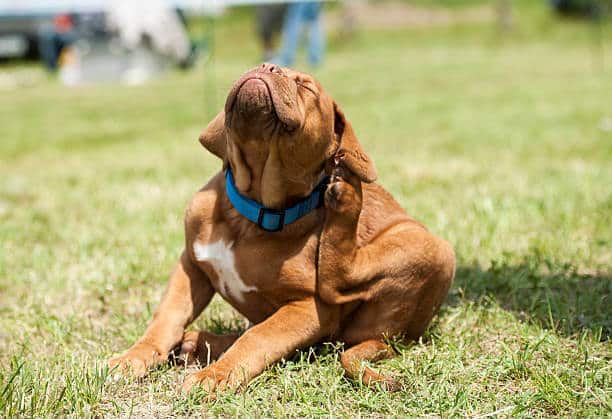
Seasonal changes can also cause your dog to shed more than normal. In the winter, dogs typically grow a thicker coat of fur in order to stay warm.
When spring arrives and the weather starts to warm up, your dog’s body will start shedding that thicker coat in order to adjust to the change in temperature. This is perfectly normal behavior and nothing to be concerned about.
If you notice that your dog is shedding more than usual, it’s important to take a closer look at their diet and overall health. Dogs who are not well-nourished are more likely to shed excessively.
Make sure your pet is eating high-quality food that is appropriate for their age, breed, and activity level. If you’re unsure about what type of food to feed your dog, consult with us here at Our Dogs World 101 or your veterinarian.
Overall, there are a variety of reasons why your dog may be shedding more than normal. Seasonal allergies, changes in temperature, and poor nutrition can all lead to increased shedding.
Additionally, Dogs who are stressed or anxious are also more prone to excessive shedding. If you think your pet may be experiencing stress, try to identify the source of their anxiety and take steps to alleviate it.
Common causes of stress in dogs include changes in routine, separation anxiety, and loud noises. If you’re having trouble pinpointing the source of your dog’s stress, consult with a veterinarian or us for help.
Excessive shedding can be frustrating, but it’s important to remember that it is usually not a cause for concern. In most cases, increased shedding is simply the result of seasonal changes or allergies.
However, if you notice that your dog is shedding excessively and also displaying other signs of illness, such as lethargy, diarrhea, or vomiting, it’s important to consult with a veterinarian right away. These could be signs of a more serious underlying health condition that needs to be treated.
Do Dogs Shed More As They Age?

Dogs are known to be man’s best friend, but they’re also known for being shedding machines. Dogs shed their hair for a variety of reasons, including to regulate their body temperature and to keep their coat clean and healthy.
But did you know that dogs shed more as they age?
As dogs get older, their bodies go through a lot of changes. Their metabolism slows down, which can cause them to lose muscle mass and gain weight.
Their bones and joints become less flexible and they may start to experience arthritis pain. And their hair follicles produce less hair, which leads to thinner, weaker hair shafts.
All of these changes can cause Dogs Shed More Than Normal.
But don’t worry, there are a few things you can do to help your furry friend through this difficult time.
First, make sure they’re getting enough exercise. Dogs who are active and have a healthy weight are less likely to experience joint pain and other age-related health problems.
Secondly, add some supplements to their diet that are specifically designed for senior dogs. These supplements can help to improve the quality of their coat and skin and reduce shedding.
Finally, brush them regularly with a good quality dog brush. This will help to remove any loose hair and distribute their natural oils throughout their coat, keeping it healthy and looking its best.
Do you have an aging dog at home? What tips do you have for dealing with increased shedding? Share your thoughts in the comments below!
How Can I Reduce My Dogs Shedding And Keep My House Clean?
Dogs are wonderful creatures, and they bring so much joy to our lives. But let’s be honest – they also come with a lot of hair. Dogs shedding is just a part of life, but it doesn’t have to take over your home. There are a few simple things you can do to reduce your dog’s shedding and keep your house clean.
1. Use the right brush: A good quality brush will make a big difference in the amount of hair your dog sheds. Dogs with long coats should be brushed daily, while shorter-coated dogs can get by with being brushed once or twice a week.
2. Bathe your dog occasionally during summer: Dogs tend to shed more during the summer months, so giving them a bath every now and then can help to reduce the amount of hair in your home.
3. Vacuum regularly: Dogs shed hair constantly, so vacuum often to keep the hair at bay.
4. Use an allergy and flea control: If your dog is shedding more than normal, it could be due to allergies or fleas. Talk to your veterinarian about the best way to treat these problems.
5. Cover furniture: Dogs love to lay on furniture, but their hair can quickly make it look dirty. Invest in some slipcovers for your sofa and chairs, or put blankets down before your dog gets on the furniture.
6. Use a fatty acid supplement: Adding a fatty acid supplement to your dog’s diet can help to reduce shedding. Check with your veterinarian to see if this is right for your dog.
7. Good quality dog food: Feeding your dog a high-quality diet can also help to reduce shedding. Dogs who are well-nourished are less likely to shed excessively.
8. Brush regularly: As mentioned before, brushing your dog regularly is one of the best ways to reduce shedding. Be sure to use a brush that is designed for your dog’s coat type.
By following these simple tips, you can help to keep the hair under control and enjoy spending time with your furry friend without feeling like you’re living in a hairy mess.
Dogs Shedding More Than Normal Conclusion
Shedding is a natural process for all dogs, but that doesn’t mean it’s easy to deal with. The good news is that there are plenty of things you can do to help make the shedding process easier on both you and your dog.
We’ve outlined some of the best tips in this blog post, so be sure to give them a try. In addition, consider trying out some of the food or supplementation options we suggested.
By following these tips and using the right products, you and your furry friend can enjoy a smooth shedding season.
Do you have any additional tips to share? Let us know in the comments below!
Remember… Owning a dog should be FUN, not a chore!
My name is Mark and I currently live in Australia.
I am passionate about educating Doggie parents and helping you to make the best possible decisions to help your dog live a long, happy and healthy life.
As a Dog trainer & behaviorist I have always used The Dog Solution methods with a 100% success rate.
Feel free to contact us, and stay tuned for updates and informative posts on dog care, training, diet, and much more!
“Dogs do speak, but only to those who know how to listen” – Orhan Pamuk


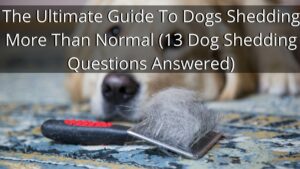


Hi Mark,
this is a great post for all dog owners. For the new ones or to-be-ones, to know what to expect and for us, experienced, it serves as a reminder.
I agree that they shed twice a year, it’s natural. It’s also natural for humans to shed twice a year, but many don’t notice it because they have short hairstyles.
However, it is important to feed our furry friends healthy and quality food. One of the first signs that they don’t feel well is the loss of glow of their hair. When my cat got ill, the first noticeable thing was exactly this. He wasn’t a shiny cat anymore. Apart from food, hygiene is the other important thing. Regular brushing with the right brush (you can ask at the pet shop about the right brush for your pet) and not a frequent bath. They need about ten days to recover the skin barrier (I am not sure about the expert word for this) that protects the skin from fungi and bacteria.
Your blog is perfect for people who want a pet. I have seen many take a pet and then return it because they can’t stand their hair. This is a good topic to think about before getting a puppy.
Pawfect!
Yes, our dogs are a fulltime job when it comes to keeping them at their best that’s for sure, but would I have it any other way? Not a chance!!
Thanks for sharing this.
Mark
Hello Mark,
Thanks for this very informative and valuable post. I’m glad that you covered the topic of dog shedding in details covering everything from why dogs are shedding, what to do if they shed more than usual, what to feed them and the whole 9 yards.
I have a Pitbull Mix and he seemed to be very good when it comes to shedding. I agree with your advice to make sure that they are eating healthy foods, exercise daily by taking them for a walk and give them a bath regularly and brush them daily.
So glad you blog on this topic, so I know what to do, even though I have been doing the daily routine of walking my dog, fed him and gave him a bath out of love. Your post had affirmed I was doing the right things.
Thanks for sharing, Vai and it sure sounds like you take real good care of your doggo!
Another great doggy post! Luckily I have a staffy so although she still definitely sheds! It’s not so bad. I do however have cats that shed lots (booooo) …We had a border collie in the past and she shed loads. To the point you would find tumble weeds of hair blowing around the laminate flooring. It’s good to know there are always to prevent and support extreme shedding. Cheers Tigan
Hahaha, I had a Golden Retriever that left tumble weeds in the house, but geez I loved her!
I love the Staffies, such characters and so loving!
My Mastiff is the same, she sheds but its manageable, plus I have white tiles and she is a fawn, so you hardly notice it 🙂
Thanks for sharing this.
Mark
What a great article! I have a German Shorthaired Pointer who is eight years old and I’ve noticed that she has been shedding more than I’ve ever noticed. I’m guessing it was the combination of a hot summer and her getting a little older. Thanks for your great tips. 😊
Hey Shannon,
Yeah, that would definitely be the case 🙂
Thanks for sharing.
Mark
My dog is a short-haired dog but he sheds so much. I always keep an ample supply of lint rollers and, since he sleeps in the bed with us, it’s an everyday routine to roll the bed. We also have 2 cats so vacuuming every day is also a must. I do brush and bathe him regularly but I learned from reading your article that I may need to change his diet. I will make sure he is getting the fatty acids he needs and also give him some eggs.
I’m hearing you with the bed problem Siobhan, my mastiff does the same and yeah it an everyday routine to roll the bed 🙂
Thanks for sharing Siobhan
Mark